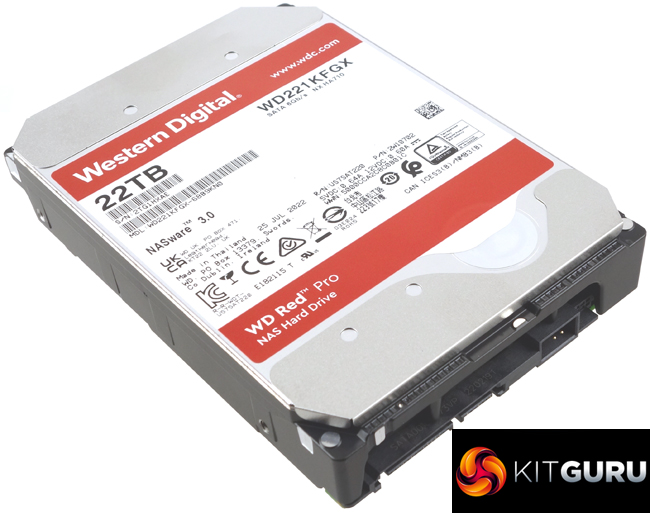WD has recently added 22TB capacity drives to a number of their HDD product lines. One of these is the NAS-focused Red Pro range which officially supports NAS devices using up to 24 bays in size. The drive features a number of WD's current HDD technologies as well as more NAS-focused Red Pro features and uses WD's latest ten disk platform. The 22TB Red Pro has a spindle speed of 7,200rpm and comes with 512MB of cache.
Because the really dense 2.2TB discs that the drive uses can potentially cause tracking problems, WD has fitted the drive with a couple of technologies to help overcome any potential problems – Triple-stage actuator (TSA) and Energy-Assisted Perpendicular Magnetic Recording (ePMR). TSA uses three pivot points in the actuator arm to more accurately position the head over the data track.
ePMR is a technology to overcome something called jitters. Jitters occur when the write current at the recording head is flipped from one direction to another, ePMR applies a constant electrical current to the main pole of the write head throughout the write process, producing a more consistent, preferred signal path that helps to reduce jitter. Reducing jitters allows for the reduction of space between bits written which in turn allows for greater areal densities and larger capacities.
The 22TB Red Pro uses OptiNAND technology. Developed by WD, OptiNAND is a flash-enhanced drive technology that integrates an iNAND UFS embedded flash drive (EFD), using 3D NAND, that sits on the hard drive PCB. Unlike the hybrid drives of the past, the NAND isn't used to store user data but is used to store the self-generated drive metadata instead of holding it on the disks themselves, which frees up more usable disc space.
The new 22TB drives also have ArmourCache protection enabled. ArmourCache is a feature of WD's OptiNAND technology which cleverly combines the performance advantages but no data protection of Write Cache enabled (WCE) mode with the data protection of Write Cache disabled (WCD) mode.
To help the drive survive the hostile environment of larger NAS enclosures (the Red Pro line supports up to 24 bay units) the drive is equipped with a multi-axis shock sensor that detects subtle shocks and dynamic fly height technology which adjusts each read-write function to compensate and protect the data. 3D Active Balance Plus ensures that the drive is properly balanced which helps lessen vibration, something that can cause major problems in large multi-disk environments, which in turn reduces noise levels.
The other very important feature that the drive uses is NASware 3.0 Technology. NASware is firmware that improves the overall reliability and performance of the drive. It uses intelligent error recovery to prevent hard drives from being dropped off the RAID due to extended error recovery which reduces the downtime needed to rebuild the RAID array. It also optimises the power requirements of the drive which can help reduce power consumption and can help to improve drive performance and reliability by reducing the temperature of the drive.
WD quote a sustained transfer rate of 265MB/s for the 22TB Red Pro, which is very slightly slower than the 20TB version. When tested with the ATTO benchmark we couldn't quite hit that maximum figure but, with test results of 259MB/s and 258MB/s for read and writes respectively, we could at least get very close.
The official workload rate for the 22TB Red Pro is 300TB/year, which is still the same figure for the whole Red Pro range from the 2TB model upwards. WD backs the Red Pro with a 5-year warranty.
We found the 22TB version of the Red Pro for £597.99 (inc VAT) on WD's online shop HERE.
Pros
- Overall performance.
- Drive technologies.
- NAS focussed features.
Cons
- All those data-saving technologies don't come cheap.
KitGuru says: WD's 22TB Red Pro drive combines WD's latest thinking on CMR hard drive technology including OptiNAND and ArmorCache with the long-standing NAS feature set of the Red Pro product line. The only real downside is that you have to pay a pretty penny for the privilege of owning one.
 KitGuru KitGuru.net – Tech News | Hardware News | Hardware Reviews | IOS | Mobile | Gaming | Graphics Cards
KitGuru KitGuru.net – Tech News | Hardware News | Hardware Reviews | IOS | Mobile | Gaming | Graphics Cards




